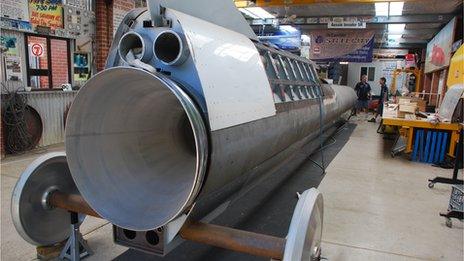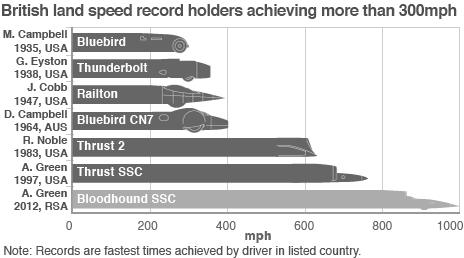Australia v Britain in battle for land speed record
- Published
Duncan Kennedy explores the Aussie Invader 5R
It's Australia versus Britain as two teams battle it out to build a car that can hit 1,000mph, reports the BBC's Duncan Kennedy.
Twenty seconds. That is how long an Australian-built supersonic rocket-propelled car will take to go from 0-1,000mph.
That is equivalent to just over 1,600km/h or one-and-a-half times the speed of sound.
Your average jumbo jet ambles along at half that speed. But this is not your standard car - it does not even have doors.
It has a hatch into which at some point over the next 12-18 months, Rosco McGlashan will squeeze himself to try to propel the machine to the speed target.
The machine has a name: Aussie Invader 5R. It is the fifth Aussie Invader Rosco McGlashan has built.
"It's all I've ever wanted to do, set the world land speed record at 1,000mph. It's my life," the Perth resident said.
But the 62-year-old is not alone in his pursuit of the high-speed holy grail.
The British are also chasing the target, in a car called Bloodhound SSC.
Bloodhound also has pedigree. The director of the project is Richard Noble and the driver/pilot is Andy Green.
Together they set the existing land speed record of 763mph (1,227 km/h) in 1997.
The British have held the land speed record for more than a quarter of a century - and they do not want to lose it.
"This is the most fascinating car I have ever worked on," Richard Noble said of Bloodhound.
'Punch through air'
Rosco McGlashan's vehicle is taking shape in a workshop next to his home in Perth.

Rosco McGlashan's car will be powered by a rocket engine
It is 15m long, will weigh 9 tonnes when fuelled with liquid oxygen/bio-kerosene, and has taken 10 years to become a reality.
The car will run on a single rocket engine, producing around 62,000 lbs of thrust or about 200,000 horsepower. By comparison, a Ford Fiesta has about 120 horsepower.
Bloodhound, meanwhile, is intended to reach Mach 1.4 - the team prefer to use fighter jet speed terminology rather than miles-per-hour.
Both Rosco McGlashan and Richard Noble go back a long way in their attempts to go fast.
Rosco McGlashan was inspired as a boy when he saw Donald Campbell come to Australia in 1964 to set the land speed record at 403mph.
Richard Noble, a 65-year-old Scottish-born aircraft designer and entrepreneur, was seduced by speed after qualifying as a pilot.
Both men are now surrounded by teams of specialists to help them achieve their goal.
Rosco has engineers as well as fluid-dynamics experts from Curtin University in Perth. Dr James Jewkes has been brought in to try to make the car more aerodynamic at supersonic speeds.
"The problem is that we don't know how a car will react at 1,000mph," he said.
"There are issues with the pocket of air the car has to punch its way through, especially as it goes through the sound barrier, which may make the car unstable."
Richard Noble heads a team that is further behind in terms of building the car, but is also placing great emphasis on aerodynamic testing.

The Bloodhound SuperSonic Car has both a rocket and a jet engine
Bloodhound differs from Aussie Invader in a number of ways including propulsion.
While Aussie Invader has just one rocket, Bloodhound has a rocket and a jet engine.
The jet engine will push the car to a given speed, then the rocket will kick in and send the car to, or possibly past, the 1,000mph mark.
"The pressures on the car at those speeds are incredible, around 12 tonnes per square metre," said Richard. "That means the car has to be as tough and as rigid as a submarine. No-one has ever done that."
Speeding bullet
It is not just technical innovation that's required to reach these astonishing speeds - money is also needed. Both teams have sponsors.
To help "sell" their project, the British are working hard to engage the public. Thousands of schools are linked to the Bloodhound website to keep up with developments.
"This is as much about education as speed," said Richard. " We have to engage young people in engineering, maths and science, and Bloodhound is one way of getting young pulses going."
Both teams are also conscious of environmental concerns. The Aussie Invader, for example, will expend three tonnes of propellant in the 20 seconds it takes to reach top speed.
But both teams say the equipment they are using is so efficient that the cars are very "green". "Bloodhound will have the same emissions as four-and-a-half lactating cows," said Richard.
Britain and Australia are not the only countries with their eyes on land speed prizes. At least two more teams are working on projects.
One is an American-Canadian venture whose car is called The North American Eagle. It is a former NASA F-104 Starfighter jet with its wings cut off.
The second project is called the Fossett LSR, named after its original backer, Steve Fossett, the American adventurer who died in a light aircraft crash in 2007.
Both the North American Eagle and the Fossett LSR are thought to be trying for the more modest goal of smashing the existing land speed record.
So reaching the 1,000mph mark appears to be a two-horse race. It could happen this year or get pushed back into 2013.
There's a striking image in one of Bloodhound's promotional videos that sums up what the British and Australians are trying to achieve.
It is a computer-generated animation of their car alongside a hand holding a Magnum .357 gun.
The car starts and the gun is fired. At first, the bullet races ahead of the car. Then the car catches up and overtakes the bullet. The bullet is left far behind as the car roars to the target.
That's how fast 1,000mph is.

- Published19 March 2012
- Published5 March 2011